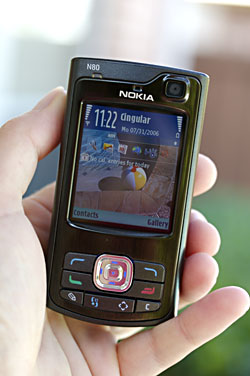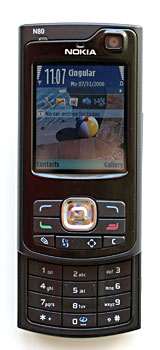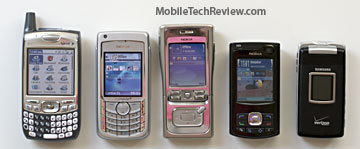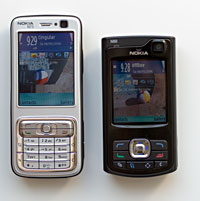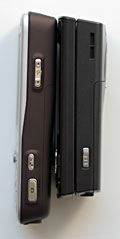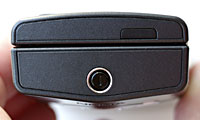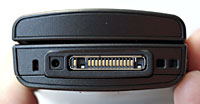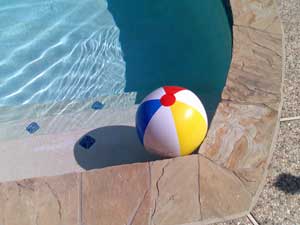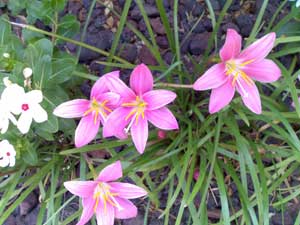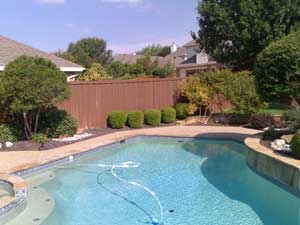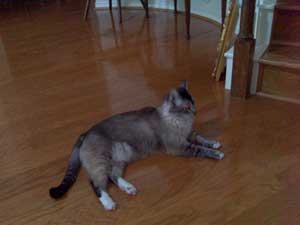
|
||||||||||

The N80 is an ergonomic delight and it's easy to use one-handed and the large 5-way directional pad is much easier to use than the nipple joystick used on several other recent S60 devices. The buttons fall in just the right places for both left and right handed users. The usual pencil, application launcher and clear keys are joined by a multimedia key (diamond icon) which launches an app that has 5 large icons for the music player, web browser, FM radio, Image Show and configure which allows you to change the assignment to any application you wish. The keypad keys, which are backlit in blue, are of adequate size and have good tactile feedback. The 5 key has two raised ridges so you can locate your finger's position without looking at the device.
Size comparison: Treo 700p, Nokia 6682, Nokia N91, Nokia N80 and Samsung a990
Comparing the Nokia N73 and Nokia N80
Above the display you'll find a blue LED that flashes brightly when the phone is asleep, light sensor which determines whether the keypad backlighting is necessary and also adjusts screen brightness, and the front facing VGA camera that's intended for self portraits and video conferencing in 3G areas (the N80 has WCDMA 3G but on the 2100MHz band used in Europe, not the US). The Mini SD card slot is on the phone's left side and the camera button and speaker are on the right side. The power button and IR window are up top and the sync and charge ports are on the bottom. The N80 uses Nokia's Pop-Port connector and comes with a stereo Pop-Port headset with integrated mic and volume controller.
The main camera lens is located on the back along with the flash. There's a macro - landscape slider just below the lens (stiff, so it won't accidentally move and change your camera setting) and no self-portrait mirror since the phone has a front-facing VGA camera. The battery lives under a door on the back and the SIM sits under the battery. Phone Features, Data and Reception The Nokia N80 is a typical GSM Nokia with very strong reception. We tested the phone on the 850MHz band with Cingular and on the 1900MHz band with T-Mobile. It did equally well with both bands and typically got an even stronger signal than the Nokia 6682 which is itself a strong performer. Voice clarity and volume are excellent with no echo or excessive white noise. Call recipients commented that we sounded like we were calling from a landline. The speaker phone is loud and is not distorted and the phone's overall volume is very loud and clear through the built in speaker. The N80 is a quad band GSM world phone that works on the 850/900/1800/1900MHz bands, so you'll be able to use it anywhere GSM service is available. In the US it's sold unlocked by importers which means you can use it with any carrier's SIM. To answer a call, simply press the call send button or open the slider. To end a call, press the call end button or close the slider if it's open. Should you wish to close the slider without ending a call, press the left shoulder button first. The phone supports MIDI, polyphonic and MP3 ringtones and comes with a pleasing selection. You can easily add your own by copying them to the appropriate folder inside the Sounds folder. The N80 has a very vigorous vibrate mode which you won't miss. You can hear it vibrate in a quiet room and it vibrates so strongly that it just might wiggle off the desk if left close to the edge. The N80 has EDGE class 10 (with fallback to GPRS) and WCDMA (UMTS, 3G) on the 2100MHz band which is used in Europe. Here in the US Cingular offers 3G coverage on the 1900MHz band with some 850MHz, so the N80's 3G won't do you any good unless you travel overseas. For those of us in the US, the N80 has strong EDGE performance getting 95k on T-Mobile and 140k on Cingular according to www.dslreports.com/mspeed. In fact web pages load quickly by EDGE standards and emails download fairly quickly, making for a pleasant data experience. Nokia includes their voice recognition software which allows you to dial contacts or launch applications using voice commands. Press and hold the right shoulder key to start voice recognition. The phone's display will show it's listening and a progress bar shows you how much time you have to say the command. This is true voice recognition and you won't record voice tags— nice. Not so nice is the job it does of recognizing commands. For a device with a good quality built-in mic and a fast CPU, it's hard to imagine why the N80 does so poorly. Test it thoroughly before trusting it, especially if you have international numbers in your contacts list. The device states what it thinks you've said in a not terribly loud or clear digitized voice, then dials in a quick 1.5 seconds unless you stop it in time. We encountered a problem when we tried to use voice commands to call any contact that happened to be in our speed dial: the voice command application would silently exit and not launch again until the phone was rebooted. The Messaging application supports POP3 and IMAP email as well as SMS and MMS messages. If you leave the Messaging application running, it will automatically check for new mail and notify you (it retrieves headers only until you tell it to download the full message) and it does not support BlackBerry Connect push email. In addition Nokia includes an IM client, but it's not for AIM or MSN out of the box- you'll need IM support from your carrier (this doesn't exist in the US) or use a service like yamigo.com. Alternatively, download Agile Messenger and install it for turnkey IM support on MSN, AIM, Yahoo and ICQ. Nokia's new web browser which uses Safari technology is the real star among included Internet applications. This browser, found on all S60 3rd Edition devices simply beats the pants off of other PDA and smartphone browsers including Blazer on Palm OS and Internet Explorer Mobile on Windows Mobile 5 (OK, it's not that hard to beat those two, but we had to wait this long for Nokia to come to the table). Opera mobile had the lead in 3rd party browsers, easily beating native offerings but we have to say the Nokia's browser is even better. It's fast, renders faithfully in desktop layout mode and very quickly in one column optimized view. The browser handles tables, JavaScript and even dHTML well and it supports multiple windows. It has a page overview mode which shows you the entire web page with an inset box you can move using the d-pad to zoom to the normal view of that part of the page. For those who've used Thunderhawk, the concept is similar. The phone also has a WAP browser (this is the one the phone uses when opening URLs in emails). They're hard to tell apart at first glance, but you can copy and paste the URL into the standard HTML browser when needed. Display, Sound and Multimedia Hands down, the Nokia N80 has one of the best displays we've seen on a mobile phone. It's sharp, colorful and really crisp. After all, high resolution crammed into a 2.1" diagonal display has got to look sharp, and it does. The Nokia has a 352 x 416 pixel display capable of displaying 262K colors. That beats Pocket PC's standard QVGA offerings and the Palm OS Treo. Though it crams a lot of pixels into a small space, the screen is easily readable, even when viewing web sites with small type. If you don't have good eyes, you might still prefer something with a lower resolution and a larger display but for most, the N80 is just fine. Though images and video look great on the N80's display, we do find that they look better on the N73. Not that the N73's screen is absolutely better, but rather the screen size relative to resolution do a better job of showing off images. Sound is loud and clear through the built-in speaker, surprisingly more so than the Nokia N91 which is billed as a music phone. Music sounds clear and rich through the included Pop-Port stereo earbud headphones and should you wish to use your own pair of headphones, the N80 comes with a Pop-Port to standard stereo 3.5mm adapter (no support for a mic when using that adapter however). The FM radio application is similar to that found on other S60 devices, and you must use the included earbuds or headphones through the adapter to tune in FM stations (the headset wire acts as an antenna). Though the Nokia doesn't have the station-pulling power of a dedicated FM radio, it does manage to pull in strong stations and the sound quality is quite good. Video playback performance is very good. We tested a 10 minute long MP4 320 x 240, AAC stereo 24kHz, 24 fps, 500k/bps video and it played back smoothly with no apparent dropped frames and with video and audio in sync. Horsepower and Performance The N80 runs Nokia's S60 3rd Edition software on Symbian OS 9.1 which offers multitasking, good security and scalable display resolutions (you'll notice that S60 devices come in a variety of resolutions). It has 30 megs of RAM to run programs with 17 megs typically free just after booting and 40 megs of flash memory for storage. That's enough to run several applications at once, and is more than most S60 devices. Still we wish Nokia would give us even more RAM; after all the stuff is cheap and S60 and Symbian are so powerful that you can really get quite a few RAM-hungry apps running at once. Should the phone run low on memory (typically when it hits 5 megs remaining or less), it will automatically shut down apps running in the background, as do Windows Mobile on Pocket PC phones and MS Smartphones. Run the camera, Gallery, web browser, contacts and an IM application and you'll likely see the device get a bit starved for memory. As a sad consolation prize, this never happens on Palm OS devices because they can't multitask. Older Series 60 phones didn't exactly fly when navigating the user interface, but the S60 3rd Edition devices are quite responsive. Moving around, opening folders, launching built-in applications and playing with most settings is a pretty fast affair. Even larger applications such as Camera and Gallery start up and are ready for use quickly enough. As usual, Nokia doesn't disclose the CPU, but we peg it as the same 220MHz Texas Instruments OMAP processor used in the Nokia N70 and N90. The N80 is faster than both of these, probably due to OS and S60 improvements and perhaps faster memory. We benchmarked the phone using FutureMark's SPMarkJava06 (a Java application that benchmarks the Java VM performance which is an indication of the phone's processing power, and both 2D and 3D performance). Here are the results: SPMarkJava score: 1796 S60 3rd Edition marks some major changes and older applications written for Series 60, S60 and S60 2nd Edition phones won't work on the Nokia N80. You'll need to get 3rd Edition compatible applications and currently there aren't too many 3rd party apps out there since 3rd Edition is so new. For memory expansion, and particularly for saving photos and videos taken with the camera, you can use the included 128 meg Mini SD card. Should you need more storage, simply buy a larger card; Nokia states the phone supports cards up to 2 gigs and we tested the phone with a SanDisk 2 gig Mini SD card which worked perfectly. Camera First a tip: hold the camera still for 2 seconds after you hear the shutter sound. Or simply watch the viewfinder until the image post-view appears. That's the shutter lag, which wouldn't be so annoying if the shutter sound were in sync so one would know when it's OK to move the camera. If you get blurry photos, follow our 2 second rule and you'll get clear, pleasing shots. For some reason, macro mode doesn't have this shutter lag, but all other modes, including Auto, do. The N73 really doesn't take photos more quickly but the autofocus action on screen gives you a clue when it's safe to move the camera, as does the in-sync shutter sound. The N80 is one of the few 3MP camera phones you can get in the US (the Samsung a990 from Verizon is the only US carrier offering, with other Nokia phones and Sony Ericsson imports filling in the rest of the field). Photos are truly very good if you follow the 2 second rule, and the N80's images lay to waste the average 1.3MP offering. Photos are fairly sharp and you can increase in-camera sharpening somewhat before images look harsh. There's a good amount of detail and you'll clearly see individual leaves and blades of grass in landscape shots, with focus falling off around the edges. The camera has good shadow detail by camera phone standards and contrast is set conservatively by default which helps maintain shadow detail. You can of course also crank up the in-camera contrast but be careful of reducing detail and blowing out colors. Better to do your post-processing using your favorite image editor on the computer. And in-camera settings for contrast and sharpening don't stick; if you exit the camera app and re-launch it, these will be back at their defaults. Colors are reasonably true with a noticeable warm bias and contrast is a bit low, leading to somewhat hazy shots. These are easily fixed in Photoshop and other image editors, and the N80's faults are indeed fewer than most camera phones. The Samsung a990 in comparison has very contrasty (but pleasing) images that have a slightly worse case of the warm to magenta color cast. To be fair, the a990 competes more directly in the camera department with the Nokia N73, since both have autofocus lenses, rather than the N80's fixed focus lens which can never be as sharp. Our only other complaint is no lens cover, something a 3MP camera warrants. Like most all Nokias, the N80 does not do well in low light situations: take a photo in a dark place, even with the flash on, and be ready to do some serious noise reduction on the PC later. File size is larger than N73's photos which is interesting given the greater detail and wider range of colors in the N73's photos. When taking the same subject at the same time of day from the same vantage point with both cameras set to their highest resolution we found that the N80's photo file size averaged 25% larger. N80 photos run between 800k and 1.3 meg for shots with a good amount of detail and color variation while the N73's are generally around 850k. More aggressive JPEG compression on the N73 is the likely cause. The camcorder can shoot video at a maximum of 352 x 288 pixels in 24 bit color with AAC 16kHz mono audio at 15fps. It has 3 quality settings, high, medium (both MP4) and low for sharing (MMS) in 3GP format. Video quality is good by camera phone standards, though not as impressive as the N80's still shots by any means. It is clear overall with some artifacting and noise visible in shadows and dark areas. The video stabilization feature does a good job of reducing handheld jerkiness, but does reduce detail a bit. Bluetooth and WiFi WiFi may not be an absolute must on a smartphone, but it's certainly a popular and important feature to business users. While most Pocket PC phones, the T-Mobile SDA MS smartphone and some other Nokia S60 devices have WiFi, by no means is it a given: just look at the WiFi-less Treo phones, Cingular 2125 and Motorola Q. Given the N80's capable email client, excellent web browser and high resolution display, WiFi is a natural fit and indeed the device is a pleasure to use when browsing the web over WiFi. Not to mention WiFi's high speeds are a good consolation for those of us who are using the N80 in the US where we can't take advantage of the phone's 3G capabilities. WiFi supports WEP encryption (64 and 128 bit), WPA and 802.1x and has a site survey feature so you can scan for available access points. Connections are reliable and range is comparable to PDAs, which is to say a bit less than notebook range but still very usable. We managed to keep a standard 802.11g connection alive at a distance of 65 feet through several beefy walls with no problems. Battery life takes a hit when using WiFi, similar to other PDA phones. Use WiFi for an hour per day and you'll be fine... several hours WiFi use per day warrants a trip to the charger or a spare battery. The Nokia N80 has a Bluetooth 1.2 with support for headset, handsfree, DUN, FTP, Object Push profiles and more. Nokia Bluetooth keyboard driver pre-installed, which hints at business use, though you'll use it for email and not Office documents since the included QuickOffice software offers viewers only. The device paired easily with a Mac running Tiger, a Windows XP PC, Nokia 770 and played well with a variety of popular Bluetooth headsets (and Motorola HF800 car kit), each of which had good voice clarity and volume. Software, Syncing and USB Since the N80 is a business or power user's phone crossed with a high-end multimedia camera phone, the software bundle is diverse. 3rd party offerings for S60 3rd Edition devices are still slim compared to the old Series 60 days (for example, phones like the Nokia 7610, Nokia 6682 and earlier S60 editions like the Nokia N90). The selection should continue growing, as S60 3rd Edition is still quite new but most of what you'll need comes pre-installed on the phone. Other than a task manager, additional video player and more advanced file manager, I can't say I've hungered for more. OK, and games too S60 PIM applications are strong. Contacts has support for pretty much every field found in MS Outlook and groups, while the calendar has alarms, repeat events, day, week and month views. S60 also has notes and Tasks both of which sync to MS Outlook. The N80 comes with a software CD containing PC Suite 8.6 and LifeBlog 2. Always check for the latest versions of those applications, which you can download for free from Nokia's web site. PC Suite is an impressive one-stop application these days, and it far surpasses MS ActiveSync for Windows Mobile and even Palm Desktop. You'll use it to sync your Calendar, Contacts, Notes and Tasks to and from Outlook, browse the phone, send multimedia files, use the phone as a wireless modem and more. It supports connection over the included CA-53 USB cable and Bluetooth. The phone supports three different USB modes: PC Suite, Data Transfer (the phone acts as a mass storage device like a USB drive) and PictBridge for printing to PictBridge enabled printers over USB. Mac users: Apple hasn't yet updated iSync to add the most recent Nokia S60 phones but you can download the free mactomster iSync plugin for iSync 2.3 on Mac OS 10.7.4 here (iSync 2.2 on OS X 10.4.6 also available). The fellow who wrote the plugin is German so the instructions won't be easy on English speakers. Here's the quick version: put the plugin folder in /applications/iSync.app/Contents/PlugIns/ApplePhoneConduit.syncdevice/Contents/Plugins. You'll need to right click on iSync (or option click) and select "Show Package Contents" to navigate to the directories listed. The plugin supports the N80, N73, E61 and quite a few other devices. If that all sounds too overwhelming, there are pay-for plugins too. But really, it's easy and I've had no problem syncing the N80 to my Mac for Contacts, Calendar and Tasks. Battery First, a tip: if you're not in an area with UMTS 2100MHz service (generally available only in parts of Europe), go into phone settings and set the phone to run in GSM mode only rather than the default dual mode. That will save battery life because the phone won't hunt for UMTS service which it will never find. The Nokia N80 has an 820 mAh Lithium Ion battery (Nokia BL-5B) which isn't much juice for a full-featured phone. That said, battery life was better than we expected and the phone lasted 2.5 days on a charge with more than moderate use. This included daily web surfing over EGE for 30 minutes, 30 minutes of WiFi surfing, checking email a few times per day over EDGE, taking photos, watching 20 minutes worth of videos, listening to FM radio for 45 minutes, using the device for PIM lookups and MS Office document viewing and talking about 20 minutes (all per day). That's pretty good and is comparable to Palm and Pocket PC phones. If you find you're getting significantly less, be sure to enable sleep mode (which is enabled by default), turn off UMTS searching and make sure you have a genuine Nokia battery (some shady resellers put good fakes in the box). Conclusion An ambitious smartphone that lives up to its feature set; everything works well— from smartphone features, to imaging, WiFi, Bluetooth and a very good camera. Even more unique is that the N80 is quite compact and very stylish, two things that can't be said of many smartphones. The N80 boasts Nokia's usual strong RF, great voice quality and solid Bluetooth. WiFi is reliable, the camera is sweet despite that shutter lag and the screen is simply gorgeous. The N80 has great ergonomics, a seemingly solid slider and overall good stability (our unit has the most recent firmware). Nokia' s new web browser is simply excellent! Pro: Great looks, small phone that packs many, many features. Responsive, stable and has the more popular Mini SD slot rather than an RS-MMC slot. The display is super with high resolution, clarity and strong colors. Camera is quite good, video isn't bad. Easy to use software and well-designed hardware. WiFi is a big plus and quad band phone with EDGE and Euro-3G will keep you connected most anywhere in the world. Plays well with Bluetooth devices, has very good sound through the built-in speaker and included Pop-Port headphones. Has pretty much all the software you'll need to make the most of the phone. Con: Pricey when purchased without a contract. Voice Command is abysmal. Battery life could be better. Web site: www.nokia.com Est. Price: $550 unlocked with no contract, considerably less in countries where sold by carriers with contract
| ||||||||||
